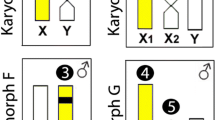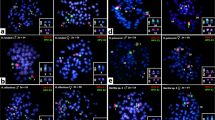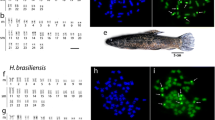Abstract
Harttia is a genus in the subfamily Loricariinae that accommodates fishes popularly known as armored catfishes. They show extensive karyotypic diversity regarding interspecific numerical/structural variation of the karyotypes, with the presence of the XX/XY1Y2 multiple sex chromosome system, as found in H. carvalhoi. In this context, this study aimed to characterize Harttia punctata chromosomally, for the first time, and to infer the rearrangements that originated the X1X1X2X2/X1X2Y multiple sex chromosome system present in this species. The data obtained in this study, with classical (Giemsa, C-banding and AgNORs) and molecular methodologies (fluorescence in situ hybridization) and chromosome microdissection, indicated that a translocation between distinct acrocentric chromosomes bearing rRNA genes, accompanied by deletions in both chromosomes, might have originated the neo-Y chromosome in this species. The data also suggest that the multiple sex chromosome systems present in H. carvalhoi and H. punctata had an independent origin, evidencing the recurrence of chromosome alterations in species from this genus.




Similar content being viewed by others
References
Alves AL, Oliveira C, Foresti F (2003) Karyotype variability in eight species of the subfamilies Loricariinae and Ancistrinae (Teleostei, Siluriformes, Loricariidae). Caryologia 56:57–63
Andreata AA, Almeida-Toledo LF, Oliveira C, Toledo-Filho AS (1993) Chromosome studies in Hypoptopomatinae (Pisces, Siluriformes, Loricariidae): II ZZ/ZW sex chromosome system, B-chromosomes, and constitutive heterochromatin differentiation in Microlepdogaster leucofrenatus. Cytogenet Cell Genet 63:215–220
Artoni RF, Bertollo LAC (2001) Trends in the karyotype evolution of Loricariidae fish (Siluriformes). Hereditas 134:201–210
Artoni RF, Bertollo LAC (2002) Evolutionary aspects of the ZZ/ZW sex chromosome system in the Characidae fish, genus Triportheus. A monophyletic state and NOR location on the W chromosome. Heredity 89:15–19
Artoni RF, Falcão JN, Moreira-Filho O, Bertollo LAC (2001) An uncommon condition for a sex chromosome system in Characidae fish. Distribution and differentiation of the ZZ/ZW system in Triportheus. Chromosom Res 9:449–456
Bertollo LAC, Takahashi CS, Moreira-Filho O (1978) Cytotaxonomic considerations on Hoplias lacerdae (Pisces, Erythrinidae). Braz J Genet 2:103–120
Blanco DR, Vicari MR, Lui RL, Traldi JB, Bertollo LA, Moreira-Filho O (2013) The role of the Robertsonian rearrangements in the origin of the XX/XY1Y2 sex chromosome system and in the chromosomal differentiation in Harttia species (Siluriformes, Loricariidae). Rev Fish Biol Fish 23:127–134
Born GG, Bertollo LAC (2000) An XX/XY sex chromosome system in a fish species, Hoplias malabaricus with a polymorphic NOR-bearing X chromosome. Chromosom Res 8:111–118
Centofante L, Bertollo LAC, Moreira-Filho O (2006) Cytogenetic characterization and description of an XX/XY1Y2 sex chromosome system in catfish Harttia carvalhoi (Siluriformes, Loricariidae). Cytogenet Genome Res 12:320–324
Charlesworth D, Charlesworth B, Marais G (2005) Steps in the evolution of heteromorphic sex chromosomes. Heredity 95:118–128
Cioffi MB, Martins C, Bertollo LAC (2010) Chromosome spreading of associated transposable elements and ribosomal DNA in the fish Erythrinus erythrinus. Implications for genome change and karyoevolution in fish. BMC Evol Biol 10:271
Costa-Silva GJ (2009) Análise filogenética entre gêneros da subfamília loricariinae (Siluriformes: Loricariidae) com ênfase no gênero Harttia, baseada em caracteres moleculares. MSc dissertation (in Portuguese) Botucatu, Brazil: Programa de Pós-Graduação em Ciências Biológicas
de Oliveira RR, Souza IL, Venere PC (2006) Karyotype description of three species of Loricariidae (Siluriformes) and occurrence of the ZZ/ZW sexual system in Hemiancistrus spilomma Cardoso & Lucinda, 2003. Neotrop Ichthyol 4:93–97
de Oliveira RR, Feldberg F, Anjos MB, Zuanon J (2007) Karyotype characterization and ZZ/ZW sex chromosome heteromorphism in two species of the catfish genus Ancistrus Kner, 1854 (Siluriformes: Loricariidae) from the Amazon basin. Neotrop Ichthyol 5:301–306
de Oliveira RR, Feldberg F, Anjos MB, Zuanon J (2008) Occurrence of multiple sexual chromosomes (XX/XY1Y2 and Z1Z1Z2Z2/Z1Z2W1W2) in catfishes of the genus Ancistrus (Siluriformes: Loricariidae) from the Amazon basin. Genetica 134:243–249
Diniz D, Moreira-Filho O, Bertollo LAC (2007) Molecular cytogenetics and characterization of a ZZ/ZW sex chromosome system in Triportheus nematurus (Characiformes, Characidae). Genetica 133:85–91
Epplen JT, McCarrey JR, Sutou S, Ohno S (1982) Base sequence of a; cloned snake W chromosome DNA fragment and identification of a male-specific putative mRNA in the mouse. Proc Natl Acad Sci USA 79:3798–3802
Ferreira IA, Bertollo LAC, Martins C (2007) Comparative chromosome mapping of 5S rDNA and 5S Hind III repetitive sequences in Erythrinidae fishes (Characiformes) with emphasis on the Hoplias malabaricus ‘species complex’. Cytogenet Genome Res 118:78–83
Foresti F, Oliveira C, Almeida-Toledo LF (1993) A method for chromosome preparations from large specimens of fishes using ‘in vitro’ short treatment with colchicine. Experientia 49:810–813
Galetti PM Jr, Foresti F (1986) Evolution of the ZZ/ZW system in Leporinus (Pisces, Anostomidae). Cytogenet Cell Genet 43:43–46
Griffiths SP (2000) The use of clove oil as an anaesthetic and method for sampling intertidal rockpool fishes. J Fish Biol 57:1453–1464
Haaf T, Schmid M (1984) An early stage of ZZ/ZW sex chromosomes differentiation in Poecilia sphenops var. melanistica (Poeciliidae, Cyprinodontiformes). Chromosoma 89:37–41
Hatanaka T, Galetti PM Jr (2004) Mapping of the 18S and 5S ribosomal RNA genes in the fish Prochilodus argenteus Agassiz, 1829 (Characiformes, Prochilodontidae). Genetica 122:239–244
Howell WM, Black DA (1979) Location of the nucleolus organizer regions on the sex chromosomes of the banded killifish, Fundulus diaphanus. Copeia 3:544–546
Howell WM, Black DA (1980) Controlled silver-staining of nucleolus organizer regions with a protective colloidal developer: a 1-step method. Experientia 36:1014–1015
Ijdo JW, Wells RA, Baldini A, Reeders ST (1991) Improved telomere detection using a telomere repeat probe (TTAGGG)n generated by PCR. Nucl Acids Res 19:4780
Jones KW, Singh L (1985) Snakes and the evolution of sex chromosomes. Trends Genet 2:55–60
Kavalco KF, Pazza R, Bertollo LAC, Moreira-Filho O (2004) Heterochromatin characterization of four fish species of the family Loricariidae (Siluriformes). Heredity 141:237–242
Kavalco KF, Pazza R, Bertollo LAC, Moreira-Filho O (2005) Karyotypic diversity and evolution of Loricariidae (Pisces, Siluriformes). Heredity 94:180–186
Kitano J, Peichel CL (2011) Turnover of sex chromosomes and speciation is fishes. Environ Biol Fish 94:549–558
Levan A, Fredga K, Sandberg AA (1964) Nomenclature for centromeric position on chromosomes. Hereditas 52:201–220
Lucchesi JC (1999) On the origin of sex chromosomes. Bioessays 21:188–190
Lui RL, Blanco DR, Margarido VP, Moreira-Filho O (2009) First description of B chromosomes in the family Auchenipteridae, Parauchenipterus galeatus (Siluriformes) of the São Francisco River basin (MG, Brazil). Micron 40:552–559
Machado TC, Pansonato-Alves JC, Pucci MB, Nogaroto V, Almeida MC, Oliveira C, Foresti F, Bertollo LAC, Moreira-Filho O, Artoni RF, Vicari MR (2011) Chromosomal painting and ZW sex chromosomes differentiation in Characidium (Characiformes, Crenuchidae). BMC Genet 12:65
Mariotto S, Artoni RF, Miyazawa CS (2004) Occurrence of sexual chromosome, of the type ZZ/ZW in Ancistrus cf. dubius (Loricariidae, Ancistrinae) of the Paraguay River Basin, Mato Grosso, Brazil. Caryologia 57:327–331
Mariotto S, Centofante L, Vicari MR, Artoni RF, Moreira-Filho O (2011) Chromosomal diversification in ribosomal DNA sites in Ancistrus Kner, 1854 (Loricariidae, Ancistrini) from three hydrographic basins of Mato Grosso, Brazil. Comp Cytogenet 5:289–300
Martins C, Galetti PM Jr (1999) Chromosomal localization of 5S DNA genes in Leporinus fish (Anostomidae, Characiformes). Chromosom Res 7:363–367
Moran P, Martinez JL, Garcia-Vazquez E, Pendas AM (1996) Sex chromosome linkage of 5S rDNA in rainbow trout (Oncorhynchus mykiss). Cytogenet Genome Res 75:2–3
Moreira-Filho O, Bertollo LAC, Galetti PM Jr (1993) Distribution of sex chromosome mechanisms in neotropical fish and description of a ZZ/ZW system in Parodon hilarii (Parodontidae). Caryologia 46:115–125
Nanda I, Schartl M, Feichtinger W, Epplen JT, Schmid M (1992) Early stages of sex chromosome differentiation in fish as analysed by simple repetitive DNA sequences. Chromosoma 101:301–310
Oliveira C, Foresti F, Hilsdorf AWS (2009) Genetics of neotropical fish: from chromosomes to populations. Fish Physiol Biochem 35:81–100
Phillips RB, Ihssen PE (1985) Identification of sex chromosomes in lake trout (Salvelinus namaycush). Cytogenet Cell Genet 39:14–18
Pinkel D, Straume T, Gray JW (1986) Cytogenetic analysis using quantitative, highsensitivity, fluorescence hybridization. Proc Natl Acad Sci USA 83:2934–2938
Rapp Py-Daniel LH, Oliveira EC (2001) Seven new species of Harttia from the Amazonian-Guyana region (Siluriformes: Loricariidae). Ichthyol Explor Freshw 12:79–96
Reed KM, Phillips RB (1995) Molecular cytogenetic analysis of the double-CMA3 chromosome of lake trout, Salvelinus namaycush. Cytogenet Cell Genet 70:104–107
Rodrigues RM (2010) Estudos cromossômicos e moleculares em Loricariinae com ênfase em species de Rineloricaria (Siluriformes, Loricariidae): uma perspective evolutiva. MSc dissertation (In portuguese). Instituto de Biociências da Universidade de São Paulo, Brazil, p 2018
Rosa R, Bellafronte E, Moreira-Filho O, Margarido VP (2006) Constitutive heterochromatin, 5S and 18 rDNA genes in Apareiodon sp. (Characiformes, Parodontidae) with a ZZ/ZW sex chromosome system. Genetica 128:159–166
Rosa KO, Ziemniczak K, Barros AV, Nogaroto V, Almeida MC, Cestari MM, Artoni RF, Vicari MR (2012) Numeric and structural chromosome polymorphism in Rineloricaria lima (Siluriformes: Loricariidae): fusion points carrying 5S rDNA or telomere sequence vestiges. Rev Fish Biol Fish 22:739–749
Schemberger MO, Bellafronte E, Nogaroto V, Almeida MC, Schühli GS, Artoni RF, Moreira-Filho O, Vicari MR (2011) Differentiation of repetitive DNA sites and sex chromosome systems reveal closely related group in Parodontidae (Actinopterygii: Characiformes). Genetica 139:1499–1508
Sumner AT (1972) A simple technique for demonstrating centromeric heterochromatin. Exp Cell Res 75:304–306
Traldi JB, Blanco DR, Vicari MR, Martinez JF, Lui RL, Artoni RF, Moreira-Filho O (2013) Physical mapping of (GATA)n and (TTAGGG)n sequences in species of Hypostomus (Siluriformes, Loricariidae). J Genet 92:127–130
Vicari MR, Moreira-Filho O, Artoni RF, Bertollo LAC (2006) ZZ/ZW sex chromosome system in an undescribed species of the genus Apareiodon (Characiformes, Parodontidae). Cytogenet Genome Res 114:163–168
Ziemniczak K, Barros AV, Rosa KO, Nogaroto V, Almeida MC, Cestari MM, Moreira-Filho O, Artoni RF, Vicari MR (2012) Comparative cytogenetics of Loricariidae (Actinopterygii: Siluriformes): emphasis in Neoplecostominae and Hypoptopomatinae. Ital J Zool 79:492–501
Acknowledgments
The authors are grateful to Osvaldo T. Oyakawa (MZUSP) for the identification of the specimens; to Luis H. da Silva and Pedro L. Gallo for help with the sampling; to the Instituto Brasileiro do Meio Ambiente e dos Recursos Naturais Renováveis (IBAMA—License Number: 10538-1) and the Instituto Estadual de Florestas (IEF/MG) for authorization to collect the material. This study was financed by the Fundação de Amparo à Pesquisa do Estado de São Paulo (FAPESP), Conselho Nacional de Desenvolvimento Científico e Tecnológico (CNPq) Coordenação de Aperfeiçoamento de Pessoal de Nível Superior (CAPES) and the Fundação Araucária (Fundação Araucária de Apoio ao Desenvolvimento Científico e Tecnológico do Estado do Paraná).
Author information
Authors and Affiliations
Corresponding author
Rights and permissions
About this article
Cite this article
Blanco, D.R., Vicari, M.R., Lui, R.L. et al. Origin of the X1X1X2X2/X1X2Y sex chromosome system of Harttia punctata (Siluriformes, Loricariidae) inferred from chromosome painting and FISH with ribosomal DNA markers. Genetica 142, 119–126 (2014). https://doi.org/10.1007/s10709-014-9759-4
Received:
Accepted:
Published:
Issue Date:
DOI: https://doi.org/10.1007/s10709-014-9759-4




